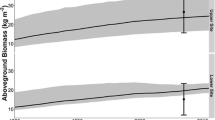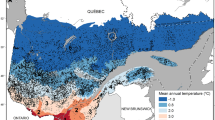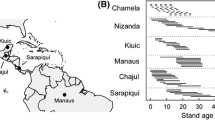Abstract
Forest biomass growth is almost universally assumed to peak early in stand development, near canopy closure, after which it will plateau or decline. The chronosequence and plot remeasurement approaches used to establish the decline pattern suffer from limitations and coarse temporal detail. We combined annual tree ring measurements and mortality models to address two questions: first, how do assumptions about tree growth and mortality influence reconstructions of biomass growth? Second, under what circumstances does biomass production follow the model that peaks early, then declines? We integrated three stochastic mortality models with a census tree-ring data set from eight temperate forest types to reconstruct stand-level biomass increments (in Minnesota, USA). We compared growth patterns among mortality models, forest types and stands. Timing of peak biomass growth varied significantly among mortality models, peaking 20–30 years earlier when mortality was random with respect to tree growth and size, than when mortality favored slow-growing individuals. Random or u-shaped mortality (highest in small or large trees) produced peak growth 25–30 % higher than the surviving tree sample alone. Growth trends for even-aged, monospecific Pinus banksiana or Acer saccharum forests were similar to the early peak and decline expectation. However, we observed continually increasing biomass growth in older, low-productivity forests of Quercus rubra, Fraxinus nigra, and Thuja occidentalis. Tree-ring reconstructions estimated annual changes in live biomass growth and identified more diverse development patterns than previous methods. These detailed, long-term patterns of biomass development are crucial for detecting recent growth responses to global change and modeling future forest dynamics.




Similar content being viewed by others
References
Acker SA, Halpern CB, Harmon ME, Dyrness CT (2002) Trends in bole biomass accumulation, net primary production and tree mortality in Pseudotsuga menziesii forests of contrasting age. Tree Physiol 22:213–217
Applequist MB (1958) A simple pith locator for using with off-center increment cores. J For 56:141
Binkley D, Stape JL, Ryan MG, Barnard HR, Fownes J (2002) Age-related decline in forest ecosystem growth: an individual-tree, stand-structure hypothesis. Ecosystems 5:58–67
Bormann FH, Likens GE (1979) Catastrophic disturbance and the steady-state in Northern hardwood forests. Am Sci 67:660–669
Bradford JB, Kastendick DN (2010) Age-related patterns of forest complexity and carbon storage in pine and aspen-birch ecosystems of northern Minnesota, USA. Can J For Res 40:401–409
Brienen RJW, Gloor E, Zuidema PA (2012) Detecting evidence for CO2 fertilization from tree ring studies: the potential role of sampling biases. Glob Biogeochem Cycles 26:GB1025
Buchman RG, Pederson SP, Walters NR (1983) A tree survival model with application to species of the Great Lakes region. Can J For Res 13:601–608
Bunn AG (2008) A dendrochronology program library in R (dplR). Dendrochronologia 26:115–124
Caspersen JP, Pacala SW, Jenkins JC, Hurtt GC, Moorcroft PR, Birdsey RA (2000) Contributions of land-use history to carbon accumulation in US forests. Science 290:1148–1151
Caspersen JP, Vanderwel MC, Cole WG, Purves DW (2011) How stand productivity results from size- and competition-dependent growth and mortality. PLoS ONE 6:e28660
Clark DA, Brown S, Kicklighter DW, Chambers JQ, Thomlinson JR, Jian N (2001) Measuring net primary production in forests: concepts and field methods. Ecol Appl 11:356–370
Clark JS, Wolosin M, Dietze M, Ibanez I, LaDeau S, Welsh M, Kloeppel B (2007) Tree growth inference and prediction from diameter censuses and ring widths. Ecol Appl 17:1942–1953
Cole CT, Anderson JE, Lindroth RL, Waller DM (2010) Rising concentrations of atmospheric CO2 have increased growth in natural stands of quaking aspen (Populus tremuloides). Glob Change Biol 16:2186–2197
Cook ER, Peters K (1981) The smoothing spline: a new approach to standardizing forest interior tree-ring width series for dendroclimatic studies. Tree-Ring Bull 41:45–53
Coomes DA, Holdaway RJ, Kobe RK, Lines ER, Allen RB (2012) A general integrative framework for modeling woody biomass production and carbon sequestration rates in forests. J Ecol 100:42–64
Davis SC, Hessl AE, Scott CJ, Adams MB, Thomas RB (2009) Forest carbon sequestration changes in response to timber harvest. For Ecol Manage 258:2101–2109
Dixon GE, Keyser CE (2011) Northeast (NE) variant overview forest vegetation simulator. U.S. Department of Agriculture, Forest Service, Forest Service Management Service Center, Fort Collins
Duchesne L, Ouimet R, Morneau C (2003) Assessment of sugar maple health based on basal area growth pattern. Can J For Res 33:2074–2080
Foster JR, Burton JI, Forrester JA, Liu F, Muss JD, Sabatini FM, Scheller RM, Mladenoff DJ (2010) Evidence for a recent increase in forest growth is questionable. Proc Natl Acad Sci 107:E86–E87
Fraver S, Jonsson BG, Jönsson M, Esseen PA (2008) Demographics and disturbance history of a boreal old-growth Picea abies forest. J Veg Sci 19:789–798
Frelich LE (2002) Forest dynamics and disturbance regimes studies from temperate evergreen-deciduous forests. Cambridge University Press, Cambridge
Genet H, Breda N, Dufrene E (2009) Age-related variation in carbon allocation at tree and stand scales in beech (Fagus sylvatica L.) and sessile oak (Quercus petraea (Matt.) Liebl.) using a chronosequence approach. Tree Physiol 30:177–192
Goulden ML, McMillan AMS, Winston GC, Rocha AV, Manies KL, Harden JW, Bond-Lamberty BP (2011) Patterns of NPP, GPP, respiration, and NEP during boreal forest succession. Glob Change Biol 17:855–871
Gower ST, McMurtrie RE, Murty D (1996) Above-ground net primary production decline with stand age: potential causes. Trends Ecol Evol Res 11:378–382
Gustafson EJ, Sturtevant BR (2013) Modeling forest mortality caused by drought stress: implications for climate change. Ecosystems 16:60–74
Hartmann H (2011) Will a 385 million year-struggle for light become a struggle for water and for carbon? - How trees may cope with more frequent climate change-type drought events. Glob Change Biol 17:642–655
Holmes RL (1983) Computer-assisted quality control in tree-ring dating and measurement. Tree-Ring Bull 43:69–78
Holzwarth F, Kahl A, Bauhus J, Wirth C (2012) Many ways to die, partitioning tree mortality dynamics in a near-natural mixed deciduous forest. J Ecol. doi:10.1111/1365-2745.12015
Hurst JM, Allen RB, Coomes DA, Duncan RP (2011) Size-specific tree mortality varies with neighborhood crowding and disturbance in a montane Nothofagus forest. PLoS ONE 6:e26670
Jenkins JC, Chojnacky DC, Heath LS, Birdsey RA (2004) Comprehensive database of diameter-based biomass regressions for North American tree species. Gen Tech Rep NE-319. U.S. Department of Agriculture, Forest Service, Northeastern Research Station, Newtown Square
Johnson SE, Abrams MD (2009) Age class, longevity and growth rate relationships: protracted growth increases in old trees in the eastern United States. Tree Physiol 29:1317–1328
Johnson EA, Miyanishi K (2008) Testing the assumptions of chronosequences in succession. Ecol Lett 11:419–431
Kira T, Shidei T (1967) Primary production and turnover of organic matter in different forest ecosystems of the Western Pacific. Ecol Soc Jpn 17:70–87
Lichstein JW, Wirth C, Horn HS, Pacala SW (2009) Biomass chronosequences of United States forests: implications for carbon storage and forest management. In: Wirth C, Gleixner G, Heimann M (eds) Old-growth forests: function, fate and value. Ecological studies vol. 207. Springer, Berlin, pp 301–341
Lines ER, Coomes DA, Purves DW (2010) Influences of forest structure, climate and species composition on tree mortality across the eastern US. PLoS ONE 5(10):e13212
Lorimer CG, Dahir SE, Nordheim EV (2001) Tree mortality rates and longevity in mature and old-growth hemlock-hardwood forests. J Ecol 89:960–971
Luyssaert S, Schulze-Detlef E, Borner A, Knohl A, Hessenmoller D, Law BE, Ciais P, Grace J (2008) Old-growth forests as global carbon sinks. Nature 455:213–215
Malhi Y, Baker TR, Phillips OL, Almeidas S, Alvarez E, Arroyo L, Chave J, Czimczik CI, Di Fiore A, Higuchi N, Killeen TJ, Laurance SG, Laurance WF, Lewis SL, Montoya LMM, Monteagudo A, Neill DA, Vargas PN, Patino S, Pitman NCA, Quesada CA, Salomao R, Silva JNM, Lezama AT, Martinez RV, Terborgh J, Vince B, Lloyd J (2004) The above-ground coarse wood productivity of 104 Neotropical forest plots. Glob Change Biol 10:563–591
McCune B, Grace JB (2002) Analysis of ecological communities. MjM Software Design, Gleneden Beach
McCune G, Mefford MJ (2011) PC-ORD. Multivariate analysis of ecological data. Version 6.0. MjM Software, Gleneden Beach
Metsaranta JM, Lieffers VJ (2010) Patterns of inter-annual variation in the size asymmetry of growth in Pinus banksiana. Oecologia 163:737–745
Odum E (1969) The strategy of ecosystem development. Science 164:262–270
Pacala SW, Canham CD, Silander JA Jr (1993) Forest models defined by field measurements. I. The design of a northeastern forest simulator. Can J For Res 23:1980–1988
Phipps RL, Whiton JC (1988) Decline in long-term growth trends of white oak. Can J For Res 18:24–32
Pregitzer KS, Euskirchen ES (2004) Carbon cycling and storage in world forests: biome patterns related to forest age. Glob Change Biol 10:2052–2077
R Development Core Team (2011) R: a language and environment for statistical computing. R Foundation for Statistical Computing, Vienna. ISBN 3-900051-07-0, URL http://www.R-project.org/
Rhemtulla JM, Mladenoff DJ, Clayton MK (2009) Historical forest baselines reveal potential for continued carbon sequestration. Proc Natl Acad Sci 106:6082–6087
Runkle JR (1985) Disturbance regimes in temperate forests. In: Pickett STA, White PS (eds) The ecology of natural disturbance and patch dynamics. Academic Press, San Diego, pp 17–33
Ryan MG, Binkley D, Fownes JH (1997) Age-related decline in forest productivity: pattern and process. Adv Ecol Res 27:213–262
Ryan MG, Binkley D, Fownes JH, Giardina CP, Senock RS (2004) An experimental test of the causes of forest growth decline with stand age. Ecol Monogr 74:393–414
Smith FW, Long JN (2001) Age-related decline in forest growth: an emergent property. For Ecol Manage 144:175–181
Taylor SL, MacLean DA (2005) Rate and causes of decline of mature and overmature balsam fir and spruce stands in New Brunswick, Canada. Can J For Res 35:2479–2490
Vanderwel MC, Coomes DA, Purves DW (2013) Quantifying variation in forest disturbance and its effects on aboveground biomass dynamics, across the eastern United States. Glob Change Biol 19:1504–1517
Williams AP, Allen CD, Miller CI, Swetnam TW, Michaelson J, Still CJ, Leavitt SW (2010) Forest responses to increasing aridity and warmth in the southwestern United States. Proc Natl Acad Sci 107:21289–21294
Wirth C (2009) Old-growth forests: function, fate and value, a synthesis. In: Wirth C, Gleixner G, Heimann M (eds) Old-growth forests: function, fate and value. Ecological studies vol 207. Springer, Berlin, pp 465–491
Xu C, Turnbull MH, Tissue DT, Lewis JD, Carson R, Schuster WSF, Whitehead D, Walcroft AS, Li J, Griffin KL (2012) Age-related decline of stand biomass accumulation is primarily due to mortality and not to reduction in NPP associated with individual tree physiology, tree growth or stand structure in a Quercus-dominated forest. J Ecol 100:428–440
Yamaguchi DK (1991) A simple method for cross-dating increment cores from living trees. Can J For Res 21:414–416
Acknowledgments
Funding for this research was provided by the American Revenue Recovery Act and the US Department of Interior Northeast Climate Science Center. Nick Jensen, Mike Reinikainen, John Segari, Kyle Gill, Amy Milo and others collected field data and/or measured and cross-dated tree rings. We thank Bruce Anderson and the Superior National Forest for logistical support and Shawn Fraver and two anonymous reviewers for reviewing this manuscript. Any use of trade, product, or firm names is for descriptive purposes only and does not imply endorsement by the U.S. Government.
Author information
Authors and Affiliations
Corresponding author
Additional information
Communicated by Ram Oren.
Electronic supplementary material
Below is the link to the electronic supplementary material.
Rights and permissions
About this article
Cite this article
Foster, J.R., D’Amato, A.W. & Bradford, J.B. Looking for age-related growth decline in natural forests: unexpected biomass patterns from tree rings and simulated mortality. Oecologia 175, 363–374 (2014). https://doi.org/10.1007/s00442-014-2881-2
Received:
Accepted:
Published:
Issue Date:
DOI: https://doi.org/10.1007/s00442-014-2881-2




